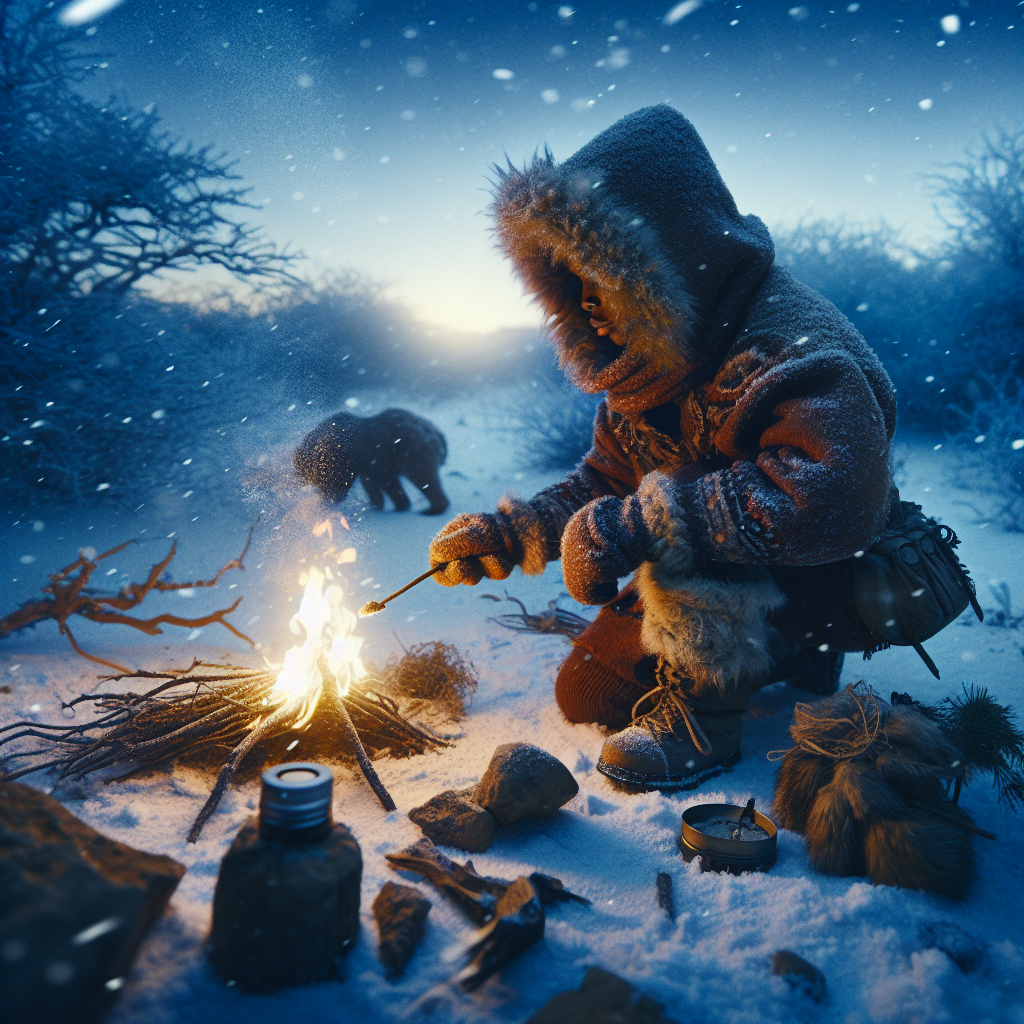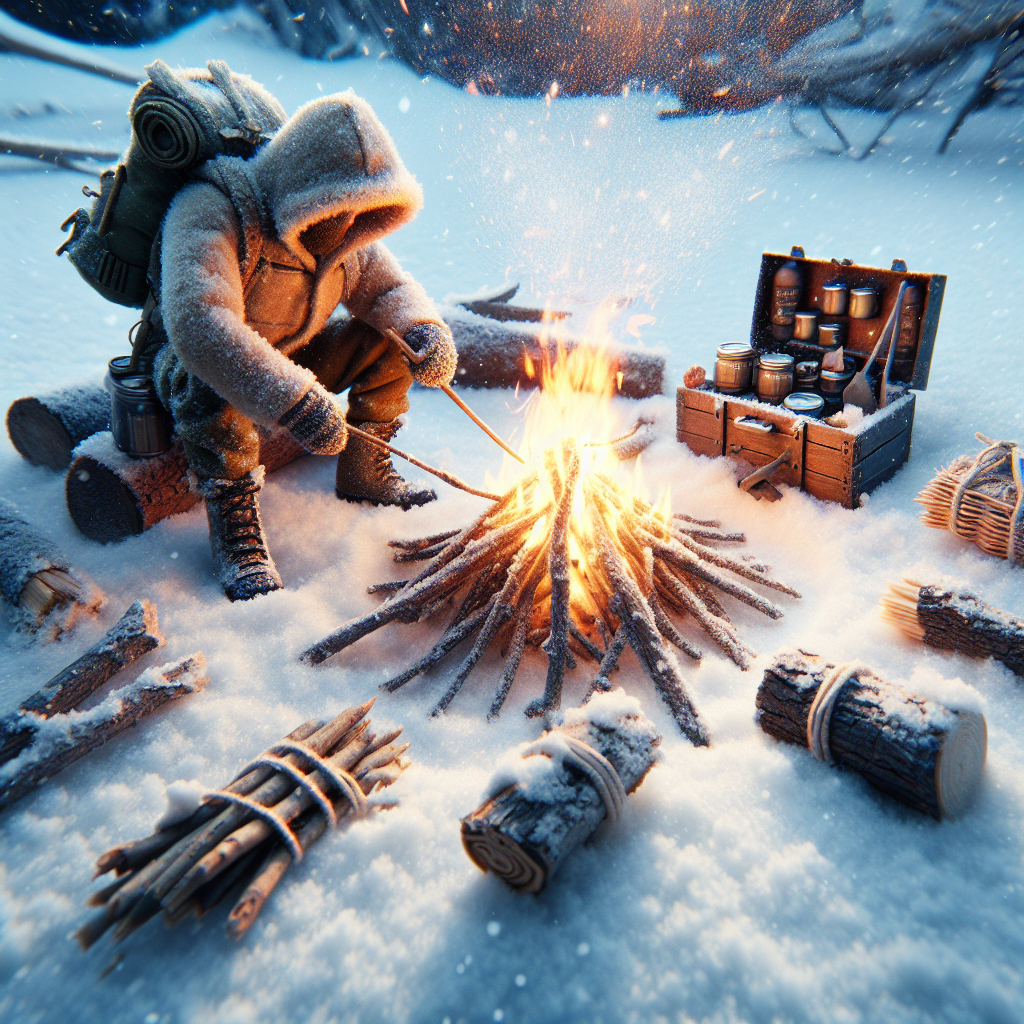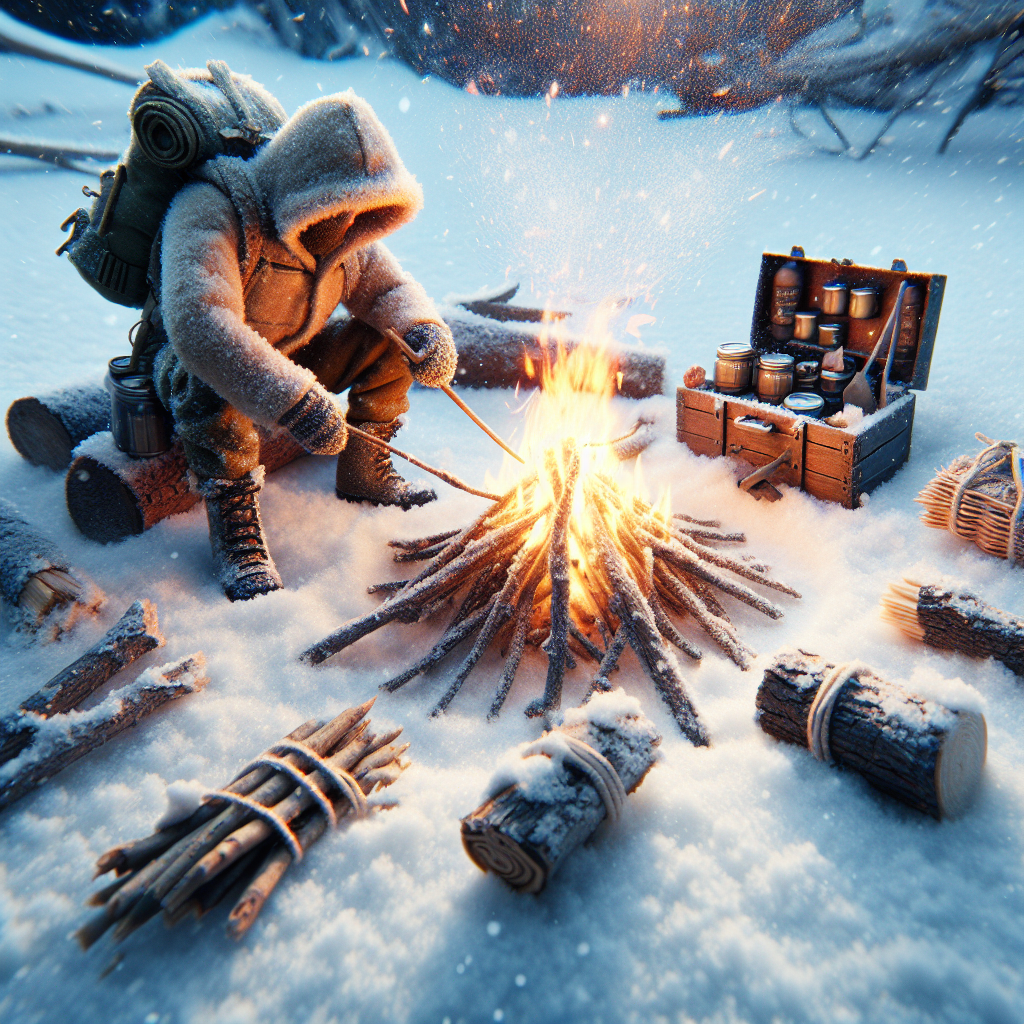Imagine you’re out in the wilderness, surrounded by a pristine white blanket of snow. The temperature drops and you find yourself in need of warmth desperately. But how do you start a fire in these freezing, snowy conditions? Fear not, for we have the answer. In this article, we will reveal the secrets to igniting a fire when the world around you is covered in snow. So grab your gloves and get ready to learn the essential techniques that will keep you cozy and safe in even the harshest winter weather.

Choosing the Right Location
When it comes to starting a fire in snowy conditions, choosing the right location is crucial for safety and efficiency. Look for a sheltered spot that provides protection from wind and snowfall. This could be under a canopy of trees, against a rock face, or even under a ledge. The key is to find a spot that will shield your fire from the elements, minimizing the chances of it being extinguished by gusts of wind or heavy snowfall.
Selecting a Sheltered Spot
A sheltered spot can provide a significant advantage when starting a fire in the snow. Look for areas where natural barriers, such as trees or rocks, can offer protection against the wind. Additionally, consider the proximity to your campsite or any other structures that may provide additional shelter. Remember to also consider factors such as overhead hazards, such as branches weighed down by snow, that may pose a safety risk.
Clearing Away Snow
Before setting up your fire, it’s essential to clear away the snow from the area. This will create a safe and stable surface for your fire pit. Use a shovel or your boots to remove the snow, ensuring you dig down to the solid ground beneath. It’s a good idea to make the cleared area larger than the size of your fire pit to prevent the heat from melting the adjacent snow and causing it to collapse onto your fire.
Creating a Windbreak
In snowy conditions, wind can be a formidable foe when starting a fire. Create a windbreak using natural materials like logs or rocks to shield your fire from gusts of wind. This will help maintain a steady supply of oxygen to the flames and prevent them from being extinguished. Build the windbreak on the side opposite to where the prevailing wind is coming from for maximum effectiveness.
Gathering Firewood
Once you have chosen the perfect location for your fire, it’s time to gather firewood. Finding dry firewood in snowy conditions can be a challenge, but with the right techniques, you’ll be able to create a roaring fire.
Finding Dry Firewood
Look for fallen branches or dead standing trees that have been naturally protected from the snow. These can often be found under dense tree canopies or against the trunks of large trees. The interior of these branches or trees may still offer dry wood that can be used as firewood. Avoid using wet or snow-covered wood as it will be difficult to ignite and sustain a fire.
Collecting Tinder
Tinder is crucial for starting a fire, especially in snowy conditions where fire-starting materials may be damp. Look for dry grass, leaves, or tree bark that can easily catch fire. It is also a good idea to carry natural tinder alternatives such as cotton balls soaked in petroleum jelly or commercial fire starters.
Preparing Kindling
Kindling refers to small sticks or twigs that help ignite the larger firewood logs. Collect dry and lightweight kindling, such as small branches or split wood. Break them into smaller pieces to create a fuel source that catches fire easily. Ensure your kindling is stored in a dry place, protected from moisture and snow.
Creating a Fire Pit
Building a fire pit in the snow will provide a stable and controlled environment for your fire.
Digging into the Snow
Using a shovel or your hands, dig a hole in the snow where you want your fire pit to be. Remove the snow until you reach the solid ground. The hole should be deep enough to contain your firewood and allow for proper airflow.
Creating a Bed of Rocks
Once the hole is dug, line the bottom with a layer of rocks. This will act as a heat sink, preventing the snow from melting and extinguishing the fire. It also elevates the firewood off the cold ground, promoting better combustion and heat distribution.
Building a Ring of Rocks
Surround your fire pit with rocks to create a ring that defines the boundaries of your fire. This will help contain the flames and prevent them from spreading beyond the designated area. The rocks can also serve as a platform for supporting cooking utensils or for sitting and enjoying the warmth of the fire.
Building the Fire
With your fire pit ready, it’s time to start building the fire. Follow these steps to ensure a successful ignition and steady flame.
Arranging the Tinder
Place your tinder, such as dry grass or small pieces of bark, in the center of the fire pit. Ensure it is loosely arranged to allow for airflow, which is crucial for igniting the flame.
Building a Teepee with Kindling
Surround the tinder with small sticks or twigs, leaning them together to form a teepee shape. Leave a small opening at the base of the teepee for lighting the fire. The teepee structure allows for proper ventilation and encourages the flames to grow and spread upwards.
Layering Firewood Logs
Once the teepee of kindling is established, carefully and progressively add larger firewood logs to the structure. Place them in a crisscross pattern, alternating the direction of each layer. This arrangement promotes airflow and helps maintain a steady flame throughout the burning process.

Igniting the Fire
To ignite the fire in snowy conditions, you have various options depending on the tools you have available.
Using Matches or a Lighter
If you have matches or a lighter, use them to ignite the tinder. Hold the flame close to the tinder bundle and gently blow on it to help the flames take hold. Once the kindling catches fire, it will gradually ignite the larger firewood logs.
Using Flint and Steel
Flint and steel can be used as an alternative to matches or a lighter. Strike the steel against the flint to create sparks, directing them towards the tinder. With some practice, you’ll be able to generate enough sparks to ignite the tinder and start your fire.
Using a Fire Starter
Fire starters, such as magnesium sticks or commercial fire starter sticks, provide a reliable and efficient way to ignite a fire in snowy conditions. Follow the manufacturer’s instructions and use the fire starter to ignite the tinder. Once the tinder catches fire, continue adding fuel to build your fire.
Maintaining the Fire
Now that your fire is burning, it’s important to know how to keep it going safely and consistently.
Adding Firewood
Regularly add firewood to maintain a steady supply of fuel. Avoid adding too much wood at once, as it can smother the fire. Gradually feed the fire with small to medium-sized logs, ensuring they catch fire before adding more.
Managing Airflow
Ventilation is key to maintaining a fire. Adjust the wood arrangement in the fire pit to allow for proper airflow, ensuring the flames receive enough oxygen to burn brightly. Avoid building the fire too close to the ground or piling snow around it, as this can restrict airflow.
Preventing Extinguishment
Take precautions to prevent your fire from being extinguished by the surrounding snow. Avoid excessive snowfall from burying the fire and obstructing airflow. Additionally, be mindful of any shifting winds that may suddenly expose the fire to gusts or blow snow into the fire pit.
Preparing for Emergencies
No matter how well-prepared you are, it’s important to have a contingency plan and be prepared for emergencies.
Keeping Emergency Supplies
Carry a well-stocked emergency kit with essentials such as extra clothing, food, water, and a first aid kit. In snowy conditions, it’s also important to have cold weather gear, including extra blankets, hand warmers, and waterproof matches or lighters.
Knowing Emergency Techniques
Educate yourself on emergency techniques, such as how to treat hypothermia, frostbite, or other cold-related injuries. Knowing how to react in such situations can make a significant difference in maintaining personal safety.
Having a Backup Plan
In case your fire does not ignite or is extinguished, always have a backup plan. This can include alternative methods of heat and cooking, such as using portable stoves or heating devices designed for outdoor use. Familiarize yourself with their operation and ensure you have enough fuel or batteries to rely on them.
Extinguishing the Fire
When it’s time to leave your fire, proper extinguishment is essential to prevent wildfires or potential hazards.
Using Water or Snow
Pour water or gather snow to douse the fire. Start at the base of the fire and work your way outward, ensuring all the embers are completely extinguished. Stir the remains to cool the ashes and ensure no hot spots remain.
Dispersing the Firewood
Once the fire has been extinguished, disperse the firewood by scattering it around the cleared area. This will help prevent the fire from reigniting and minimize the impact on the surroundings.
Smothering the Fire
If using water or snow is not an option, smother the fire with dirt or sand. Use a shovel or any available tool to cover the fire with a thick layer of soil until the flames are completely smothered. As with using water, remember to stir the ashes to ensure complete extinguishment.
Safety Precautions
Starting a fire in snowy conditions requires taking necessary safety precautions to minimize risks and ensure a safe experience.
Dressing Appropriately
Dress in layers to insulate yourself from the cold and protect against frostbite. Wear waterproof and insulated boots to keep your feet warm and dry. Don’t forget to cover your head and hands with hats and gloves to prevent heat loss.
Practicing Fire Safety
Follow general fire safety guidelines to prevent accidents and injuries. Never leave a fire unattended, and always have a suitable fire extinguishing method at hand, whether it’s water, snow, or a fire extinguisher.
Being Aware of Surroundings
Stay vigilant of your surroundings while the fire is burning. Be mindful of overhanging branches or other potential hazards that could pose a risk to both you and the fire. Additionally, keep an eye on weather conditions, as changing winds or heavy snowfall can affect the stability and safety of your fire.
Leaving No Trace
Responsible outdoor enthusiasts always aim to minimize their impact on the environment. Leaving no trace means taking care of the area where you built your fire.
Cleaning the Fire Pit
Before leaving, clean the fire pit by removing any remaining logs or debris. Scrape away any ash or charred material and dispose of it properly. Leave the area as clean as you found it, or even better, cleaner.
Properly Disposing of Ashes
If required, allow the ashes to cool completely before disposal. Once cool, transfer the ashes to a suitable container, ensuring no embers remain. Properly dispose of the ashes according to local regulations or guidelines.
Packing Out Leftover Firewood
If you have any leftover firewood, pack it out with you. Leaving firewood behind can disrupt the natural environment and introduce invasive species to the area. Dispose of the firewood appropriately or save it for your next outdoor adventure.
Starting a fire in snowy conditions can be challenging, but with the right techniques and precautions, you’ll be able to create a warm and inviting campfire. Remember to always prioritize safety, respect the environment, and enjoy the magical experience of gathering around a crackling fire in the snow.

